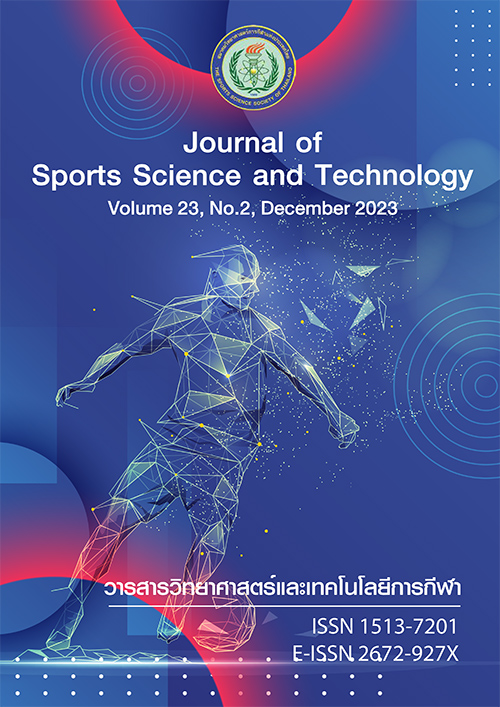ผลของการฝึกแรงต้านแบบหนักสลับเบาที่มีผลต่อสมรรถภาพแอโรบิกและแอนแอโรบิกในนักกีฬาฟุตบอลหญิง
คำสำคัญ:
การฝึกแรงต้าน, โปรแกรมหนักสลับเบา, ทาบาต้า เวท โปรโคตอล, ความแข็งแรงอดทน, สมรรถภาพแอโรบิก, พลังแอนแอโรบิก, สมรรถภาพแอนแอโรบิกบทคัดย่อ
การวิจัยครั้งนี้ มีวัตถุประสงค์ศึกษาเพื่อเปรียบเทียบ ผลของการฝึกแรงต้านแบบหนักสลับเบา ที่มีผลต่อสมรรถภาพแอโรบิก และแอนแอโรบิกในนักกีฬาฟุตบอลหญิง กลุ่มตัวอย่าง เป็นนักกีฬาฟุตบอลหญิง อายุระหว่าง 18 – 22 ปี จำนวน 20 คน แบ่งออกเป็น 2 กลุ่มๆ ละ 10 คน คือ กลุ่มทดลองที่ 1 การฝึกแรงต้านโดยใช้โปรแกรมความแข็งแรงอดทน ปริมาณความหนัก 50 – 60 % 1 RM เป็นระยะเวลา 30 วินาที (จำนวน 15 – 20 ครั้ง) สลับกับการพัก เป็นระยะเวลา 30 วินาที และกลุ่มทดลองที่ 2 ฝึกโปรแกรมความแข็งแรงอดทน แบบทาบาต้า เวทเทรนนิ่ง ปริมาณความหนัก 20 – 30 % 1 RM เป็นระยะเวลา 20 วินาที (จำนวนครั้ง 20 – 30 ครั้ง) สลับกับการพัก เป็นระยะเวลา 10 วินาที จำนวนสัปดาห์ละ 3 วัน ทำการฝึกเป็นเวลา 8 สัปดาห์ ทำการทดสอบสมรรถภาพแอโรบิก และแอนแอโรบิก ก่อนการฝึกและภายหลังการฝึกสัปดาห์ที่ 8 นำข้อมูลมาวิเคราะห์ทางสถิติ โดยใช้ Paired t- test และ t – test independent กำหนดระดับความมีนัยสำคัญทางสถิติไว้ที่ระดับ 0.05
ผลการวิจัยพบว่า หลังการฝึก 8 สัปดาห์ ทั้ง 2 กลุ่ม ค่าสมรรถภาพแอโรบิก มีค่า VO2max เฉลี่ยเพิ่มขึ้นจาก 30.34 ± 4.0 เป็น 35.61 ± 3.7 มล./กก./นาที และ 30.38 ± 3.7 เป็น 37.68 ± 2.8 มล./กก./นาที ตามลำดับ และแอนแอโรบิกมีค่าเฉลี่ยเพิ่มขึ้น 314.50 ± 59 เป็น 365 ± 92 วัตต์ และ 303.40 ± 47 เป็น 389 ± 48 วัตต์ แตกต่างจากก่อนการฝึกอย่างมีนัยสำคัญทางสถิติที่ระดับ 0.05 ตามลำดับ หลังการฝึก 8 สัปดาห์ ปริมาณการใช้ออกซิเจนสูงสุดกลุ่มทดลองที่ 2 เพิ่มมากกว่ากลุ่มทดลองที่ 2 คิดเป็น 13.41 เปอร์เซ็นต์ แตกต่างกันอย่างมีนัยสำคัญทางสถิติที่ระดับ 0.05 แต่ในขณะที่สมรรถภาพแอแอนโรบิก ผลการฝึกระหว่างกลุ่มทดลองทั้ง 2 กลุ่มไม่แตกต่างกัน
อภิปรายผล การฝึกแรงต้าน โดยใช้โปรแกรมความแข็งแรงอดทน และทาบาต้า เวทเทรนนิ่ง แบบหนักสลับเบา เป็นการเสริมสมรรถภาพทางกาย สามารถเพิ่ม สมรรถภาพแอโรบิก และแอนแอโรบิก อาจเป็นผลของการพัฒนาเส้นใยกล้ามเนื้อสีขาว(Type IIa) และการอดทนต่อกรดแลคติกเพิ่มขึ้น จากการฝึกที่ใช้ระยะเวลาในการพักสั้น ส่งผลต่อการปรับตัวของร่างกายเพิ่มปริมาณเอนไซม์ในการสังเคราะห์พลังงานและเพิ่มการจัดเก็บสารตั้งต้นในกล้ามเนื้อ17 จากการฝึกแรงต้านซ้ำๆกัน
สรุปผล จากข้อมูลที่มีอยู่สรุปได้ว่าการฝึกแรงต้านโปรแกรมความแข็งแรงอดทน และทาบาต้าสามารถปรับปรุงสมรรถภาพแอโรบิกและแอนแอโรบิกได้
เอกสารอ้างอิง
Konstantinos Spyrou , Tomás T Freitas , Elena Marín-Cascales 1, Pedro E Alcaraz Physical and
Physiological Match-Play Demands and Player Characteristics in Futsal: A Systematic Review Front Psychol
Nov 6;11:569897. doi: 10.3389/fpsyg.2020.569897.
Bangsbo J. Energy demands in competitive soccer. J Sports. 1994;12:S5-12.
Bangsbo et al, Reilly et al Science and Football III 1997
Charoen Krabuanrat. Science of coaching. 2nd ed. Bangkok: Sintana copy center company limited;
Guzman D, Young M, NSCA -National Strength & Conditioning Association, editors. Strength Training
for Soccer. Champaign, IL: Human Kinetics; 2022
Gollhofer A, Schmidtbleicher D. Stretch reflex responses of the human M. triceps surae following
mechanical stimulation. J Biomech [Internet]. 1989;22(10).
Grgic J, Schoenfeld BJ, Orazem J, Sabol F. Effects of resistance training performed to repetition
failure or non- failure on muscular strength and hypertrophy: A systematic review and meta-analysis. J Sport
Health Sci [Internet]. 2022;11(2):202–11.
Butrmuang M. Interval training program for athletes. Bangkok: Borisuth Printing Co.,Ltd; 2021.
I Tabata K, Nishimura M, Kouzaki Y, Ogita M. Effects of moderate-intensity endurance and high-
intensity Sci intermittent training on anaerobic capacity and VO2 max Med Sci Sports Exerc. 1 9 9 6
Oct;28(10):1327-30. Med Sports Exerc. 1996;28(10):1327–30.
Izumi Tabata Tabata training: one of the most energetically effective high-intensity intermittent
training methods. J Physiol Sci. 2019;69:559–72.
Kraemer M R Deschenes SJ. Physiological adaptations to resistance exercise. Implications for
athletic conditioning. Sports Med. 1988;6(4):246–56.
Apiluk Theanthong. Introduction to weight training. 2nd ed. Bangkok: Kasetsart university press;
Ht S, editor. Impact of Resistance Training on Endurance PerformanceA New Form of Cross-
Training? Sports Med. 1998;25:191–200.
Bell GJ, Syrotuik D, Martin TP, Burnham R, Quinney HA. Effect of concurrent strength and endurance
training on skeletal muscle properties and hormone concentrations in humans. Eur J Appl
Physiol.2000;81(5):418–27.
Hasan MF. The effect of circuit weight training on VO2Max. In: Proceedings of the 4th International
Conference on Sport Science, Health, and Physical Education (ICSSHPE 2019). Paris, France: Atlantis Press;
Ozaki H, Loenneke JP, Thiebaud RS, Abe T. Resistance training induced increase in VO2max in
young and older subjects. Eur Rev Aging Phys Act [Internet]. 2013;10(2):107–16.
Vissing T. Impact of Resistance Training on Skeletal Muscle Mitochondrial Biogenesis, Content, and
Function. Front Physiol. 2017;8.
Groennebaek T, Vissing K. Impact of Resistance Training on Skeletal Muscle Mitochondrial
Biogenesis, Content, and Function. Front Physiol. 2017;8.
Ross A, Leveritt M. Long-term metabolic and skeletal muscle adaptations to short-sprint training:
implications for sprint training and tapering. Sports Med. 2001;31(15):1063–82
Leuchtmann AB, Mueller SM, Aguayo D, Petersen JA, Ligon-Auer M, Flück M, et al. Jung & Marco
Toigo Resistance training preserves high-intensity interval training induced improvements in skeletal muscle
capillarization of healthy old men. Article number. 2020;10.
Gerson E R Campos 1 , Thomas J Luecke, Heather K Wendeln, Kumika Toma, Fredrick C
Hagerman,Thomas F Murray, Kerry E Ragg, Nicholas A Ratamess, William J Kraemer, Robert S Staron.
Muscular adaptations in response to three different resistance-training regimens: specificity of repetition
maximum training zones. J Appl Physiol. 2002 Nov;88(1-2):50-60. doi: 10.1007/s00421-002-0681-6. Epub
Aug 15






